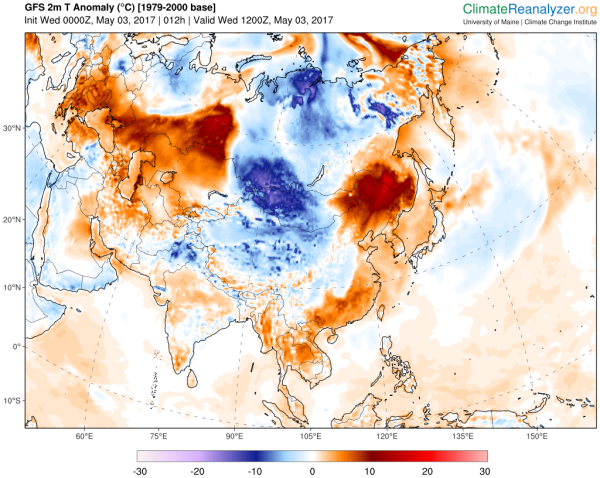Early Season Russia-Siberia Wildfire Outbreak Expands Due to Heat
3
May, 2017
An
early Siberian
and Asian wildfire outbreak that became apparent last week has
continued to flare just south of the swiftly retreating freeze line.
And while wildfires near Lake
Baikaland
further south and east toward the Russia-China border continue to
flicker, a considerable outbreak has now flared up in Western Russian
and Siberia along a zone straddling the Urals and
just south of the Yamal
Peninsula.
(Wildfires
and hotspots run west to east across Russia and Siberia in this May 3
NASA satellite shot. Note the storm system near Lake
Baikal which
has recently suppressed early season wildfire activity there. Image
source: LANCE
MODIS.)
A
trough dipping through Central Russia and Siberia has brought rain
and cooler conditions — which has suppressed some of the previously
extensive wildfire activity near and to the north of Lake
Baikal.
But temperatures in the range of 5-15 C above average along both the
Russia-China border and in Western Russia have combined with warm,
southerly winds to spur wildfire activity throughout these
regions. In
these zones, temperatures have been flaring into the 60s, 70s, and
even lower 80s F (16-27 C) through sections.
And such abnormal heat has helped to generate a high prevalence of
newly-flaring early May wildfires.
Though
wildfires in the east along the Russia-China border are still small
and lack intensity, the region near the Urals is
showing some significant flare-ups. Just west of the Urals near
56 north latitude burn scars as large as ten miles long by five miles
wide appeared in the satellite imagery as fires ripped through the
area on April 29 through May 3. These fires blanketed the region with
100 to 200 mile long smoke plumes even as the blazes steadily march
northward.
(Wildfire
flare up near 56 N just west of the Urals. For reference, north is
left side of frame, south right side. Bottom edge of frame is
approximately 80 miles. Image source: LANCE
MODIS.)
In
the east and near Lake
Baikal permafrost
often extends as far south as the Russia-China border. So many of the
fires in this region are already burning in or near permafrost zones.
In the west, permafrost is removed further north — becoming more
common beyond the 60 degree north latitude line. Hotspots in the west
are now approaching this zone, flaring as far north as the 59th
parallel, but have yet to fully cross into it.
Over
the coming days and weeks, wildfires in the permafrost zone will tend
to become more extensive as spring advances. Such burning, during
recent years, is now much more common than in the past. The increase
is due to a considerable and rapid warming near the polar region
that has
averaged 2 times the larger global warming rate (about
0.15 to 0.2 C per decade for the world and 0.3 to 0.4 C per decade
for the Arctic).
(Anomalous
warmth is spurring wildfire flare-ups in both eastern and western
Siberia and Russia today. Over the coming weak, abnormally warm
temperatures are again predicted to flare again over the Lake Baikal
region — which will likely reinvigorate the wildfires that have
already begun burning there. Image source: Climate
Reanalyzer.)
This
human-forced warming due to fossil fuel burning is producing
considerable permafrost thaw and creating new fuels for fires in a
previously-frozen region. In addition, the added heat has generated
more thunderstorms — producing more lightning strikes and other
ignition sources. As a result of this warming, the added fuels, and a
multiplication of fire ignition sources, Siberian wildfire season now
ranges from April through September and
often produces fires of a terrible magnitude.
Links:
Hat
tip to MlParrish






No comments:
Post a Comment
Note: only a member of this blog may post a comment.